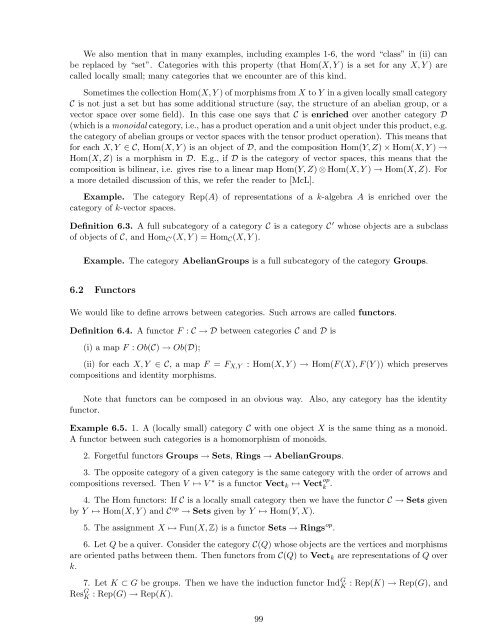Lecture notes for Introduction to Representation Theory
Lecture notes for Introduction to Representation Theory
Lecture notes for Introduction to Representation Theory
You also want an ePaper? Increase the reach of your titles
YUMPU automatically turns print PDFs into web optimized ePapers that Google loves.
We also mention that in many examples, including examples 1-6, the word “class” in (ii) can<br />
be replaced by “set”. Categories with this property (that Hom(X, Y ) is a set <strong>for</strong> any X, Y ) are<br />
called locally small; many categories that we encounter are of this kind.<br />
Sometimes the collection Hom(X, Y ) of morphisms from X <strong>to</strong> Y in a given locally small category<br />
C is not just a set but has some additional structure (say, the structure of an abelian group, or a<br />
vec<strong>to</strong>r space over some field). In this case one says that C is enriched over another category D<br />
(which is a monoidal category, i.e., has a product operation and a unit object under this product, e.g.<br />
the category of abelian groups or vec<strong>to</strong>r spaces with the tensor product operation). This means that<br />
<strong>for</strong> each X, Y C, Hom(X, Y ) is an object of D, and the composition Hom(Y, Z) × Hom(X, Y ) ⊃<br />
Hom(X, Z) is a morphism in D. E.g., if D is the category of vec<strong>to</strong>r spaces, this means that the<br />
composition is bilinear, i.e. gives rise <strong>to</strong> a linear map Hom(Y, Z) Hom(X, Y ) ⊃ Hom(X, Z). For<br />
a more detailed discussion of this, we refer the reader <strong>to</strong> [McL].<br />
Example. The category Rep(A) of representations of a k-algebra A is enriched over the<br />
category of k-vec<strong>to</strong>r spaces.<br />
Definition 6.3. A full subcategory of a category C is a category C whose objects are a subclass<br />
of objects of C, and Hom C ⊗ (X, Y ) = Hom C (X, Y ).<br />
Example. The category AbelianGroups is a full subcategory of the category Groups.<br />
6.2 Func<strong>to</strong>rs<br />
We would like <strong>to</strong> define arrows between categories. Such arrows are called func<strong>to</strong>rs.<br />
Definition 6.4. A func<strong>to</strong>r F : C ⊃ D between categories C and D is<br />
(i) a map F : Ob(C) ⊃ Ob(D);<br />
(ii) <strong>for</strong> each X, Y C, a map F = F X,Y : Hom(X, Y ) ⊃ Hom(F (X), F (Y )) which preserves<br />
compositions and identity morphisms.<br />
Note that func<strong>to</strong>rs can be composed in an obvious way. Also, any category has the identity<br />
func<strong>to</strong>r.<br />
Example 6.5. 1. A (locally small) category C with one object X is the same thing as a monoid.<br />
A func<strong>to</strong>r between such categories is a homomorphism of monoids.<br />
2. Forgetful func<strong>to</strong>rs Groups ⊃ Sets, Rings ⊃ AbelianGroups.<br />
3. The opposite category of a given category is the same category with the order of arrows and<br />
compositions reversed. Then V ⊃ V ⊕ is a func<strong>to</strong>r Vect k ⊃ Vect op .<br />
k<br />
4. The Hom func<strong>to</strong>rs: If C is a locally small category then we have the func<strong>to</strong>r C ⊃ Sets given<br />
by Y ⊃ Hom(X, Y ) and C op ⊃ Sets given by Y ⊃ Hom(Y, X).<br />
5. The assignment X ⊃ Fun(X, Z) is a func<strong>to</strong>r Sets ⊃ Rings op .<br />
6. Let Q be a quiver. Consider the category C(Q) whose objects are the vertices and morphisms<br />
are oriented paths between them. Then func<strong>to</strong>rs from C(Q) <strong>to</strong> Vect k are representations of Q over<br />
k.<br />
7. Let K → G be groups. Then we have the induction func<strong>to</strong>r Ind G<br />
Res G K : Rep(K) ⊃ Rep(G), and<br />
: Rep(G) ⊃ Rep(K).<br />
99<br />
K

















